Historic Fort Gaines is one of the top things to do on Dauphin Island, Alabama! Step back in time and learn more about Civil War history and the Gulf Coast.
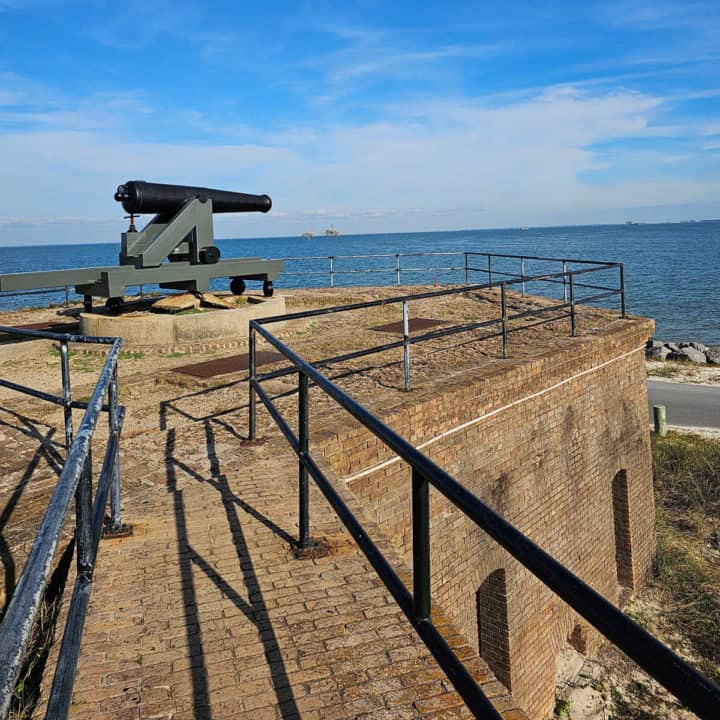
Fort Gaines
One of the best things to do on Dauphin Island is step back in time and learn about Historic Fort Gaines.
What I love about this fort is you can wander all over it. You get to experience what it is like to stand next to a cannon on top of the fort.
Once you enter the Fort you can take a self-guided tour of the fort with the pamphlet from the visitor center or wander on your own and be surprised at what you find.
Make sure to wear sunscreen and be prepared for the sun! It can get HOT HOT HOT especially in the summer.
The historic site is fun for the entire family. The tunnel systems, harbor defense, spiral stone staircases, gun placements, and more can be explored.
Home of the now-famous order "Damm the Torpedoes...Full Speed Ahead!"
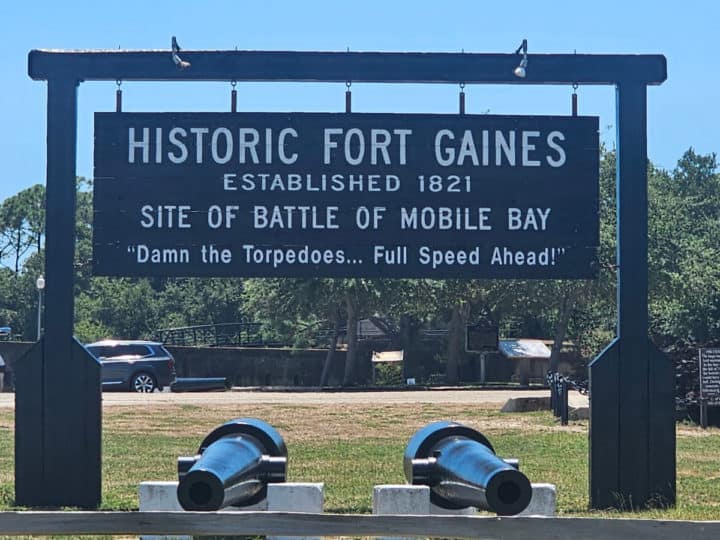
History of Fort Gaines
Fort Gaines has stood as a silent protector over Mobile Bay for over 150 years. Fort Gaines is one of the most well-preserved examples of an 1800s masonry coastal fort in the east.
Constructed in 1821, the fort was named after Edmund Pendleton Gaines, an officer in the United States Army who served for fifty years. Fort Gaines is most well known for its role during the American Civil War Battle of Mobile Bay.
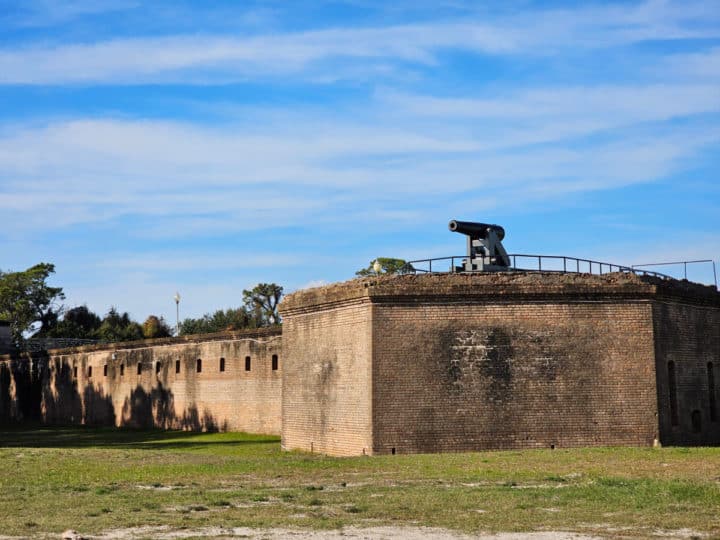
Fort Gaines and the Battle of Mobile Bay
The Battle of Mobile Bay was a naval battle that occurred between the 2nd and 23rd of August 1862, when the Union attacked one of the last open Confederate ports, Mobile Bay.
Mobile Bay was heavily protected by the Confederates throughout the war, by Forts Morgan, Gaines, and Powell, along with several earthworks and a flotilla island minefield in the bay. The forts protected two major shipping lanes that passed through the bay.
Additionally, the trio of fortifications protected Confederate blockade runners who left and entered the bay, allowing trade to continue for the Confederates.
Union Admiral David G. Farragut was tasked with closing the port and, therefore, stopping the Confederate trade that was managing to make its way past the Union blockade. Farragut planned to do this through the use of a joint naval and army attack on the bay. In command of the Army forces was Major General Gordon Granger.
Operations began on the 3rd of August, 1864, when Major General Granger and his force arrived on Dauphin Island, immediately laying siege to Fort Gaines. While Granger laid siege to Fort Gaines, Farragut was organizing his fleet and planning on how he would enter the heavily guarded Mobile Bay.
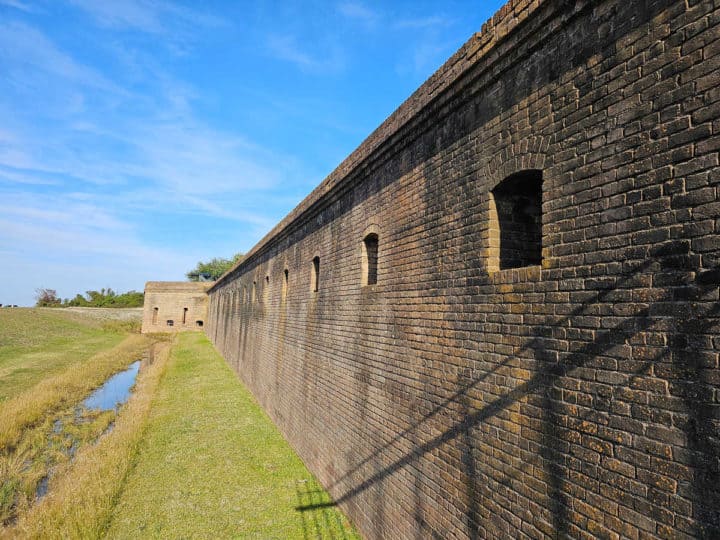
The Siege of Fort Gaines
Fort Gaines was under siege by the Union from the 5th until the 8th of August. Granger and his men outnumbered the Confederates, having landed on the island with 1,500. At the time of the siege, there were 818 men garrisoned at Fort Gaines under the command of Colonel Charles D. Anderson.
Anderson had been ordered not to surrender Fort Gaines to the Union, as it could withstand a six-month siege. For the first two days of the siege, Anderson had no intention of surrendering the fort to Granger. It was not until the morning of the 5th of August that Anderson’s resolve began to waver.
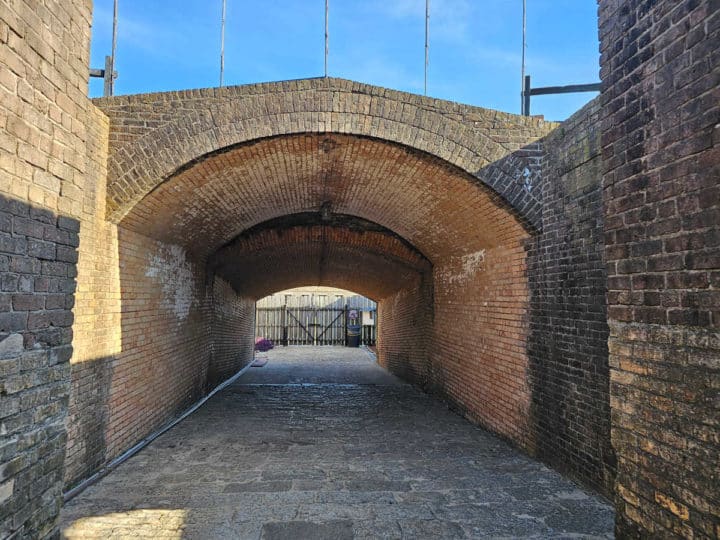
The Battle of Mobile Bay
On the morning of the 5th of August, Farragut made his move. He divided his forces, which consisted of more than a dozen wooden warships and four ironclad monitors. Farragut split his force into two parallel lines to avoid the minefields in the bay, and the 46 guns housed in Fort Morgan.
The admiral attached his ships, lashing them together so that if one was disabled, they would be able to pull it with them. Farragut, who had tied himself to the rigging of his ship the USS Hartford, watched as his fleet maneuvered its way past Fort Morgan's guns and the minefields. The fleet got into trouble when one ship veered into the minefield, and was torpedoed and sunk.
Suddenly, Farragut's fleet was under attack from the fort's guns. In response to the attack, several of his captains began stopping their ships within range of Fort Morgan’s guns, causing Admiral Farragut to issue the shouted command “Damn the torpedoes! Full speed ahead!”
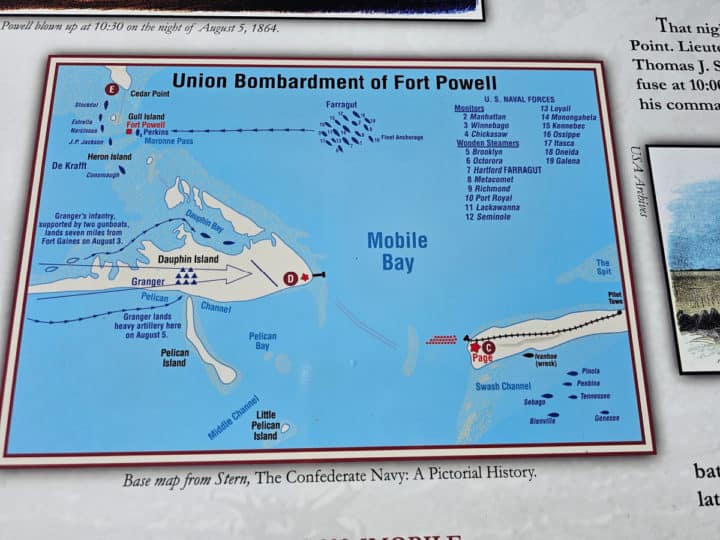
The Union ships managed to make their way into Mobile Bay, where they disabled several of the ships in the Confederate flotilla. By the second day of the naval battle, the Confederate ships were out of action. The Union then turned its attention to the forts.
Colonel Anderson had watched the Union bombard the Confederate ships from Fort Gaines, becoming increasingly concerned as the battle ensued. Fort Gaines only had 26 guns to attack the Union with, and 818 men, while the Union had 5,500 men in total and 199 guns.
On the 8th of August, Anderson decided to surrender the fort to the Union, believing they would not be able to outlast a Union attack. Fort Powell had been abandoned by the Confederates before Fort Gaines surrendered, leaving only Fort Morgan left as a defense.
The Union laid siege to Fort Morgan for two weeks, bombarding the fort while cutting off its access to the outside world. The siege of Fort Morgan lasted until the commander in charge, Brigadier General Richard Lucian Page, spiked the fort's guns and raised the white flag of surrender on August 23, 1864.
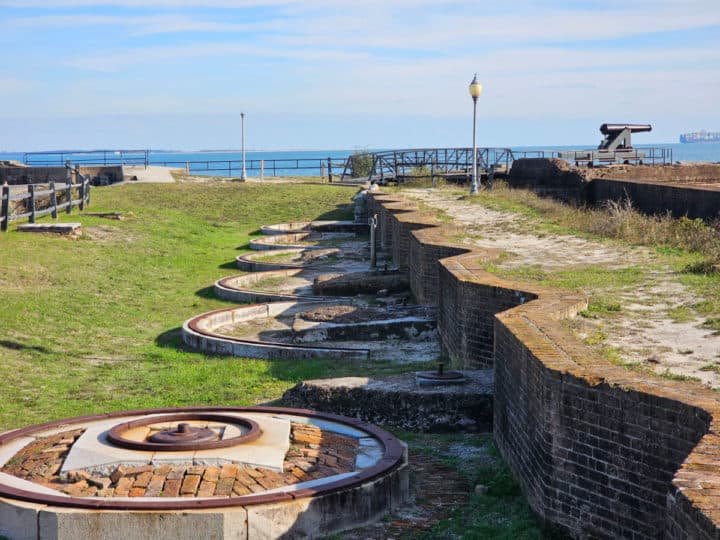
Why you will love Fort Gaines
- Historic Civil War Era Fort
- Gorgeous panoramic views of the Bay and the Gulf of Mexico
- Explore the well-preserved ramparts of Fort Gaines
- Fun gift shop and historic books
- See original cannons, a blacksmith shop, kitchens, and more.
- Learn about the history of Dauphin Island
- Famous battle of Mobile Bay history
- One of the Eleven Most Endangered Historic Sites in America
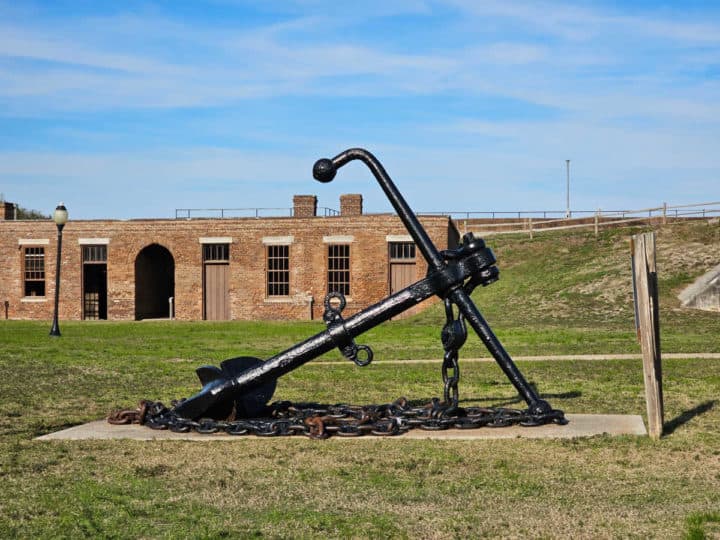
Things to know when planning a visit to Fort Gaines
Entrance Fee - Children (Ages 5 -12) are $5.00
Adults (Ages 13+) are $10.00
Address - 51 Bienville Blvd, Dauphin Island, AL 36528
Located on the eastern tip of Dauphin Island.
Phone - (251) 861-6992
Hours - The Fort is Open from 9:00 AM – 5:00 PM
The Fort will be closed on Thanksgiving Day, Christmas Eve, and Christmas Day
Please confirm with the restaurant to ensure that the hours have not changed.
Accessibility -There ground is historic and rough. There are a couple of paths through that are paved but be prepared for it to be bumpy.
Dress Code/Suggestions - Casual, make sure to wear sturdy shoes for walking on uneven ground. Sunscreen and a hat for hot summer days.
Pets - Dogs are allowed as long as they are on a leash
Parking - There is a parking area near the fort entrance.
Guided Tours - Fort Gaines provides guided tours for groups of 15 people are more with at least two weeks in advanced notice for booking and that they are done by our own soldier in period uniform which will bring history to life including cannon firing demonstration and blacksmithing.
This information is from the Dauphin Island website and should be confirmed with the fort before visiting. To schedule a group tour, contact Melinda Oalmann at 251-861-6992
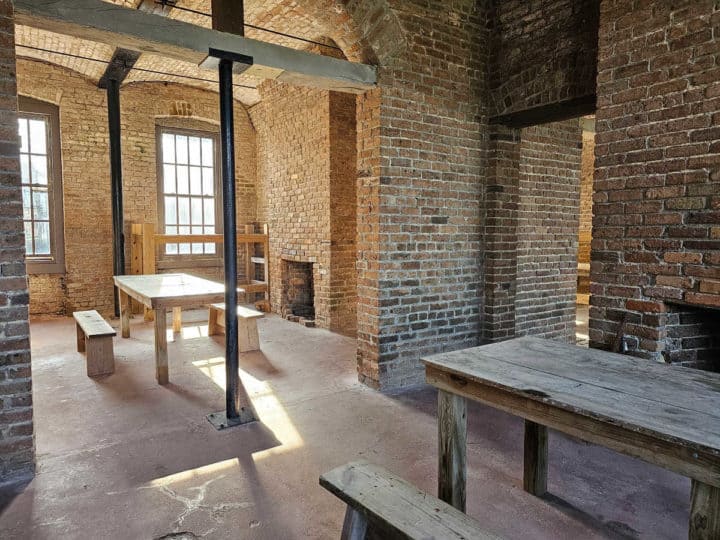
Restaurants and Attractions nearby
Mobile Bay Ferry - Hop on the ferry to Dauphin Island near the entrance to Historic Fort Morgan.
Dauphin Island Aquarium - Learn about the sea life that can be found in Mobile Bay and along the Gulf Coast while visiting the aquarium. Wait until you see the touch tank! It is so much fun!
Things to do in Fort Morgan, Alabama - All of the fun things to do and see while visiting Fort Morgan.
Shell Mound Park - See traces of Native Americans and learn about how they used to hunt and gather oysters and other shellfish.
Reel Deal BBQ & Seafood - BBQ restaurant close to the beach and main road.
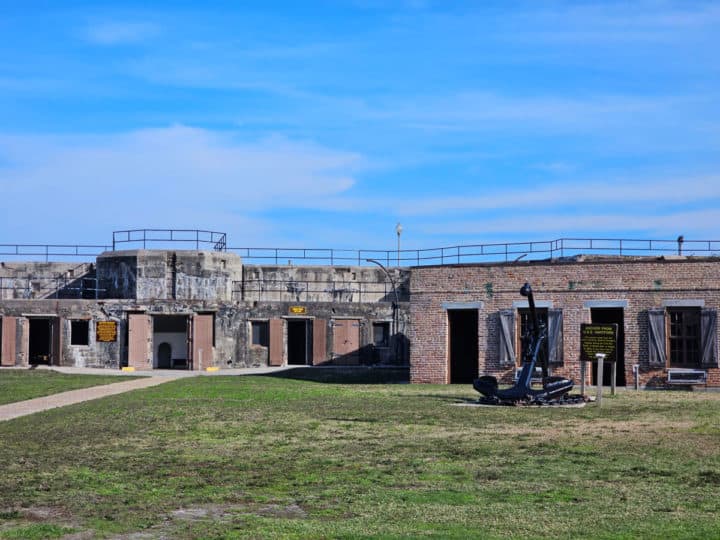
Additional Gulf Coast Articles
Fort Morgan, AL Restaurants - Check out all of the great places to eat while exploring Fort Morgan.
The Beach Club Resort and Spa - Check out this gorgeous beach resort located just down the street from the fort. The private beach is amazing.
Fort Morgan Fishing Pier - Check out the brand new fishing pier built near the historic Fort.
Don't miss our other Gulf Coast destinations including Gulf Shores, Orange Beach, Dauphin Island, Fairhope, Fort Morgan, Foley, Mobile, Bayou La Batre, Alabama and so many more!
We also have articles on the Emerald Coast of Florida including Destin, Fort Walton Beach, Pensacola Beach, Navarre Beach, Panama City Beach, Perdido Key, and more.
Keep an eye out for articles on the Gulf Coast of Alabama, Mississippi, Louisiana, Texas, and Florida!
Check out our Facebook and Instagram and TikTok pages for more great ideas for the Gulf Coast.
.

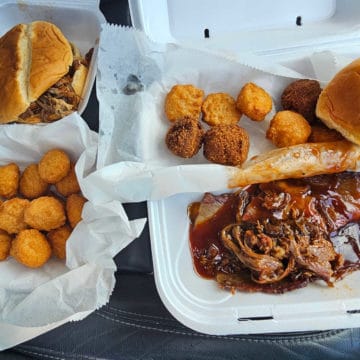
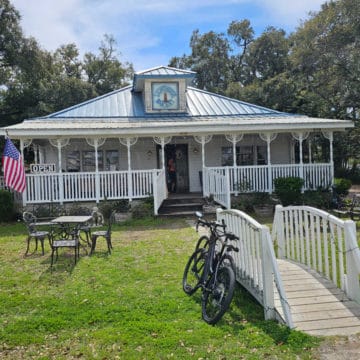
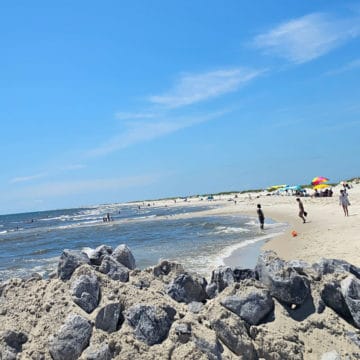
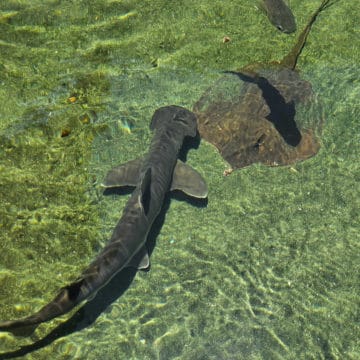
Leave a Reply